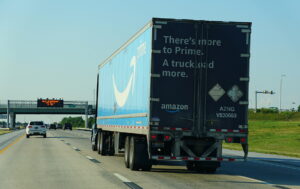It’s no secret that Amazon has a reputation for being indifferent at best to the well-being of its warehouse employees; the eCommerce giant has received extensive criticism for its draconian working environment that denies employees appropriate breaks to the point where workers are pressured to substitute trips to the restroom with using plastic bottles, and for the company’s lackluster commitment to Covid safety measures for its employees when those precautions might compromise efficiency. If all that weren’t bad enough, a report recently released by the Strategic Organizing Center (SOC) containing an analysis of data submitted by Amazon to the US Occupational Safety and Health Administration (OSHA) reveals that Amazon warehouses are much more physically dangerous places to work than their competitors.
 In 2021, there were 38,334 reported injuries at Amazon facilities, of which approximately 34,000 were serious enough that the injured worker had to miss time from work or was restricted to “light duty” by their medical provider for a period of time. This figure represents 6.8 injuries per 100 warehouse workers, a number contrasted with the 3.3 serious injuries per 100 workers reported by Amazon’s major competitors. To put it another way, one of every three warehouse workers in the US was employed by Amazon in 2021, but Amazon’s warehouse employees accounted for 49 percent – just shy of half – of all injuries in the industry that year. Moreover, when an employee is forced to miss work due to their injuries, Amazon workers are out of commission for longer than the competition’s employees, missing an average of 46.3 days, a week longer than the warehouse industry average.
In 2021, there were 38,334 reported injuries at Amazon facilities, of which approximately 34,000 were serious enough that the injured worker had to miss time from work or was restricted to “light duty” by their medical provider for a period of time. This figure represents 6.8 injuries per 100 warehouse workers, a number contrasted with the 3.3 serious injuries per 100 workers reported by Amazon’s major competitors. To put it another way, one of every three warehouse workers in the US was employed by Amazon in 2021, but Amazon’s warehouse employees accounted for 49 percent – just shy of half – of all injuries in the industry that year. Moreover, when an employee is forced to miss work due to their injuries, Amazon workers are out of commission for longer than the competition’s employees, missing an average of 46.3 days, a week longer than the warehouse industry average.
In a response to the SOC report, an Amazon spokesperson pointed out that in contrast to 2019, the injury rates in 2021 had actually fallen by 13 percent and attributed the rise in injuries between 2020 and 2021 to the influx of new employees in training in response to the increased pandemic-related demand. However, a closer inspection of the data suggests that the 2020 drop in injury rates was likely caused by a temporary easing in productivity requirements for warehouse employees due to the safety demands of the pandemic, which required employees to sanitize their stations and wash their hands. However, as those safety precautions were discarded and the productivity mandates returned, workplace injury rates bounced back as well.
Even in 2020 when Amazon’s injury rates dropped, Amazon workers were still getting injured much more frequently in comparison to other warehouse workers. That year, according to a Washington Post analysis of OSHA data, for every 200,000 hours worked (the equivalent of 100 full-time employees working for one year) Amazon saw 5.9 serious warehouse worker injuries. Across the industry, workers in non-Amazon warehouses were injured at rates of 3.1 serious injuries per 200,000 hours worked, and at Amazon’s biggest competitor, Walmart, serious warehouse injury rates were only 2.5 per 200,000 hours. In 2020, Amazon operated 638 warehouses nationwide. At 363 of those warehouses, the rates of serious injury (requiring lost time or light duty) were double the industry average or worse, and a further 137 warehouses had injury rates higher than the industry average.
What causes Amazon warehouses to be such dangerous places to work, relative to their competition? A number of former OSHA officials, as well as union representatives and current and former Amazon employees themselves, agree that the biggest problem is the amount of pressure the company places on productivity. Amazon has strict metrics requiring workers to stow, pick, and pack merchandise at incredibly high hourly volumes, with penalties and the threat of losing their jobs if employees fail to meet these targets. These stringent requirements are not only incredibly psychologically stressful, but also put incredible physical strain on a worker’s body.
The expectations that Amazon has for its workers, and the company’s attitude toward employee health and safety, is succinctly summarized in an internal “health and wellness guide” pamphlet that was leaked in 2021. In this pamphlet directed at employees of Amazon’s Tulsa warehouse, the company characterizes its workers as “industrial athletes” and describes that various employee positions may require walking “up to 13 miles a day” and others will lift a total of 20,000 pounds per shift. Rather than reducing this intense physical strain, Amazon urges its workers to “train” for their job, exercising on their days off, staying hydrated (in an environment where workers have been forced to urinate in bottles due to a lack of bathroom breaks!), eating properly in anticipation of burning 400 calories per hour on the job, and buying shoes at the end of a workday when their feet are swollen to ensure that their footwear allows plenty of room for feet to swell during work. When the document was leaked, Amazon of course backpedaled, saying it was “created in error,” but the pamphlet makes it undeniably clear that Amazon understands how taxing the work environment in their warehouses is, and refuses to do the one obvious thing that would make their employees safer: reduce their work pace.
Contact MyNJInjuryLawyer Howard P. Lesnik
If you or a loved one suffered an injury in an accident in NJ, you should contact an attorney familiar with handling these claims. An experienced NJ Injury Lawyer will know how to obtain medical records, videos, photographs, experts, locate witnesses and contact the insurance company so you can make a claim for your injuries.
My NJ Injury Lawyer Howard P. Lesnik, Esq. offers complimentary strategy sessions to address any issue or questions you may have for your injury claim in NJ.
Please contact NJ Injury Lawyer Howard Lesnik, Esq., immediately if you were involved in an accident. I personally handle NJ personal injury cases on a regular basis. Please contact me now by email, by phoning 908.264.7701, or by completing the form to the right to schedule your complimentary 30-minute strategy session. Call me direct and I will answer 5 questions that you have about your potential claim.




